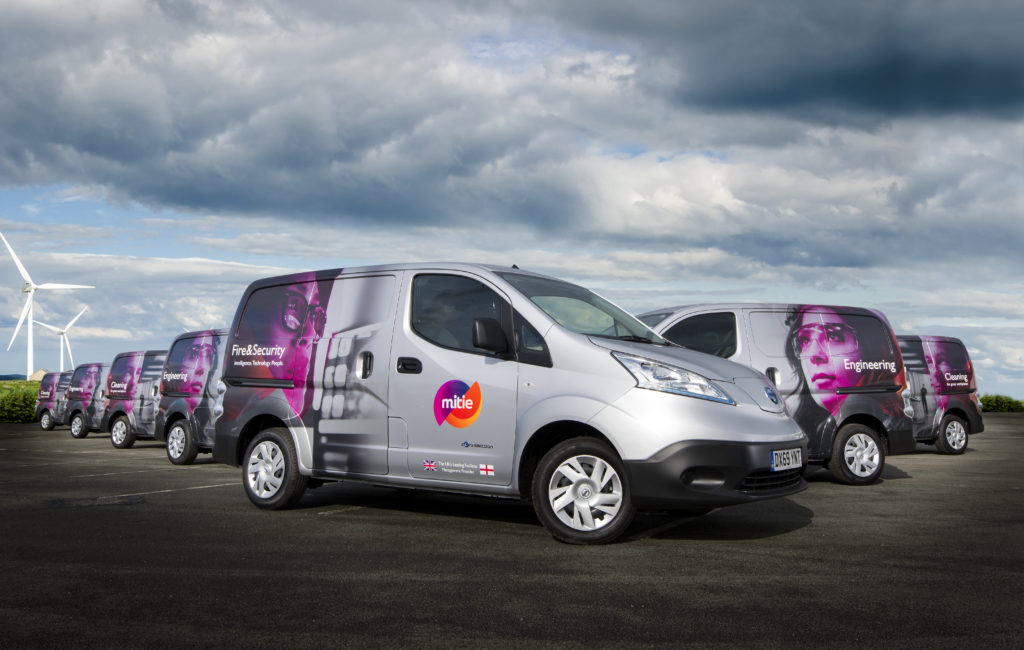
Mitie’s head of fleet and procurement outlines key challenges as the firm bids to decarbonise its fleet by 2030.
Mitie this week rolled out its first electric vans and remains on track to switch 20 per cent of its cars and light commercial fleet to EVs by the end of 2020.
But vehicle visibility and commitment from carmakers remains a key challenge, according to fleet and procurement director, Simon King.
The rollout is on track and the vehicles “have been hugely positively received by staff”, but time is of the essence if the UK is to hit net zero.
While energy supply is rapidly decarbonising, transport – which represents around a third of UK CO2 emissions – has barely moved.
“The criticality is there, so we want to go further and faster,” says King.
That requires both vehicles in volume and sufficient charging infrastructure.
King says Mitie is speaking to all car manufacturers and believes volume constraints will start to ease next year. But larger electric vans are in short supply.
“We have Nissan ENV200s now joining the fleet, replacing Vauxhall Combos that we have historically used,” says King. “There is some availability [of small vans] but larger vans with decent range continue to be a challenge.”
King says Mitie is having “interesting discussions with OEMs” for larger vans arriving in Q3 2020. “But at the moment, that is a promise rather than guaranteed availability.”
It is “slightly strange for a procurement director to have to say ‘please supply me’ rather than run a competitive tender, but it is a unique situation,” says King.
“We are talking to all the OEMs and continue to engage all the big players, but if anyone has an offering that we may not be aware of, we urge them to contact us directly. We are really keen to work with anyone that has suitable vehicles, particularly mid and large-sized vans.”
Range booster
Range is an issue for mid-sized vans, says King. He thinks a modular battery approach could solve the problem.
“If OEMs could develop a modular range with up to three batteries, for example enabling 90-180-270 miles, that gives the user a choice to meet their needs. A vehicle for central London has very different requirements [and charging options] to one operating in North Wales,” says King.
“Also, as vehicles go into the secondhand market, of which fleet is a big route, that would enable people to add or remove range [to suit their needs]. We are discussing that with some OEMs. It would really help the fleet buying industry – and decarbonise the UK fleet.”
Infrastructure challenge
The other major challenge is rapid charging infrastructure, says King. Mitie is installing chargers at its premises, at customer sites and at the homes of employees with EVs.
“But there are some homes where we can’t install chargers, where they do not have a parking space, apartment blocks etc., and we also need to top up the lower range commercial vehicles on longer journeys,” says King. “So the availability of infrastructure remains a challenge – alongside the practicalities of using it.”
Simplify payment
King has “ten plus apps” to charge his car. Requiring new rapid chargers to have contactless payment is “a good step forward,” but he says it is “unreasonable to expect commercial vehicle drivers to use multiple apps and have to top them up with their own credit.”
Mitie is currently asking drivers to pay with their own card and then charge it back to the company. Whereas with diesel, drivers use the Allstar card, and Mitie pays directly.
“Trying to replicate that is a challenge. Allstar does include some EV chargers [within its network], but coverage is low at the moment,” says King. “I am sure as the market develops we will see consolidation, but that takes time. We are seeking solutions now to make it easy for drivers to switch to EVs.”
Next steps
Despite some hurdles, King says the switch to EVs is providing the firm with learning it can share with customers and that Mitie is ahead of schedule. He expects the electric fleet will total 200 vehicles by the year-end and 717 by the end of 2020, which will make it the UK’s largest EV fleet.
The next step is to “determine the strategy of what a largely electric fleet looks like,” says King, with Mitie committed to electrifying transport by 2030 as part of the EV100 collective.
“We’re comfortable that cars and small vans will be there [in volume], but the larger vans, scaffolding lorries etc., are more challenging. So we are considering now how to address that,” he says, “because we need answers in the next three to four years.”
Advice: Chicken and egg
King says anyone considering switching fleets to EVs needs to consider two aspects in parallel.
“Engage with the OEMs as early as possible to get the vehicle pipeline in place and at the same time, get your applications for infrastructure and charging in,” he says.
“People have suggested the cars and the chargers are a chicken or egg conundrum, but they are not. You have to do them both in parallel.”
Related stories:
Mitie procurement chief: Show me the EVs
Free report: EVs and charging infrastructure for businesses
Follow us at @EnergystMedia. For regular bulletins, sign up for the free newsletter.



